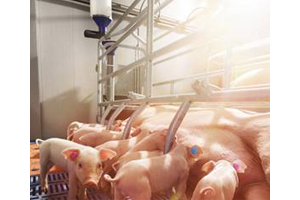Nedap: New Farrowing Feeding System

Nedap introduces ‘Farrowing Feeding’, a new system that provides a simple and trouble-free transition from traditional to fully automated feeding of sows in farrowing crates.
With this new system, each sow receives the correct amount of feed to maintain body condition during lactation. The cmpany will present this new solution at World Pork Expo 2015, Booth V528-529.
The Nedap team says the system is a response to a visible need in the swine industry. Many sow producers find it difficult to be sure sows in lactation consume enough feed. This product was created so producers can set up feeding strategies to optimise intake, helping sows stay in good condition throughout the lactation period and produce robust piglets.|
The Farrowing Feeding Unit can be installed in farrowing pens or gestation crates, attaching to any trough, regardless of brand, with a doser. Through the Nedap computerised program, facility managers are able to enter individual feeding strategies – up to 24 per day – to optimise intake. The system then dispenses feed allotments via small increments throughout the day.
The unit offers:
* The ability to feed automatically, according to the feeding cycle
* Accurate dispensing of feed at multiple feeding times per day, up to 24 times
* Setting the number of feeding times per day based on the sow’s lactation stage
* Feeding in accordance with the sow’s needs
* Adjustable dosing speed
* Removable auger
* Robust, dust and splash proof enclosure
Field tested and approved
Sow farmer Richard Wellink, owner of a sow farm in Aalten, the Netherlands, has field-tested the new system. In one section of his sow farm he installed the new Farrowing Feeding Unit.
“I have run three cycles with it and I am pleased,” Wellink says. “In the other sections I need to pull up the pipes of the dosers every day. With the Nedap Farrowing Feeding Unit I have simply put all this in a feeding curve. The sows automatically get a little more each day.”
Wellink normally feeds twice a day. The Nedap Farrowing Feeding Unit allows him to feed smaller portion sizes four times a day.
“The big advantage is that the piglets become active for a moment and they drink a little, which stimulates milk production. I notice that when these piglets are weaned, they are heavier than the ones in the other sections. What is more, the sows stay in better condition. That is important, to improve the ease of breeding back and have a good litter for the next cycle.”











